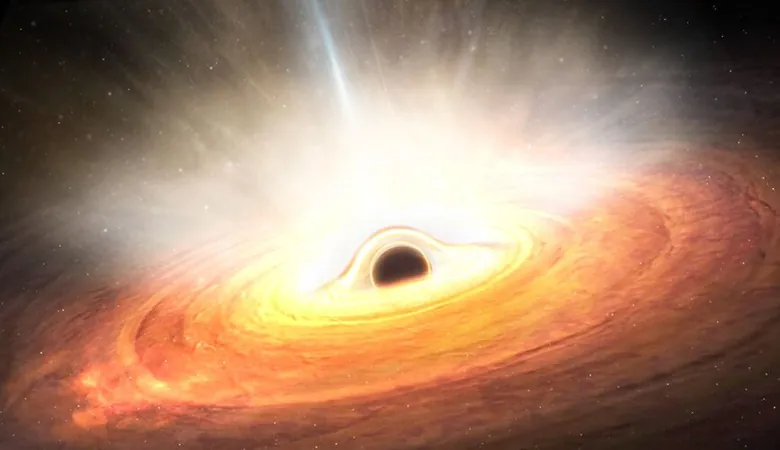
The Shocking Truth About Supermassive Black Hole Formation Unveiled by James Webb Space Telescope!
2024-12-12
Author: John Tan
Introduction
Recent groundbreaking observations from the James Webb Space Telescope (JWST) have shed light on a perplexing question in astrophysics: How did supermassive black holes (SMBHs) grow so rapidly in the early universe, less than a billion years after the Big Bang? These revelations come from the period known as Cosmic Dawn when the first galaxies emerged, and they suggest that our understanding of cosmic evolution may be fundamentally flawed.
Astonishing Discoveries
What JWST discovered was nothing short of astonishing—numerous galaxies appeared far more abundant and luminous than previously anticipated, housing SMBHs that are significantly more massive than cosmological models had foretold. This discovery challenges astronomers to rethink how these colossal black holes and their host galaxies formed and evolved so swiftly during the infancy of the universe.
The Study and Findings
In a compelling new study, an international team led by Alessia Tortosa from the National Institute for Astrophysics (INAF) focused on a select group of 21 quasars, some of the most distant celestial objects ever identified. Their analysis posits that these SMBHs rapidly accrued mass at extraordinary rates, offering a potential explanation for their unexpected sizes.
The quest to understand quasars began back in the 1950s when radio astronomers first detected them emitting vast amounts of radiation. Dubbed “quasi-stellar objects,” quasars quickly captured the attention of scientists eager to study the roots of these brilliant cosmic phenomena, believed to harbor SMBHs at their cores. However, observations from JWST demonstrated that the “seeds” of these black holes were far larger than anticipated, with one galaxy, EGSY8p7, hosting a black hole approximately 9 million times the mass of our Sun just 570 million years post-Big Bang!
Even more stunning was the discovery of UHZ1, a galaxy existing merely 470 million years after the dawn of time, which harbored a black hole of around 40 million solar masses—a figure ten times that of our Milky Way's Sagittarius A*.
Challenging Traditional Theories
Traditionally, cosmological theories proposed that there was insufficient time for such massive black holes to form in this brief window of cosmic history. However, Tortosa and her colleagues utilized data from the XMM-Newton and Chandra space telescopes, shedding light on an unanticipated connection between X-ray emissions and the dynamics of material winds ejected from these quasars. They concluded that the speed of these winds was intrinsically linked to the temperature of the gas near the black hole's corona.
Crucially, this study indicates that quasars with lower energy X-ray emissions exhibited faster wind speeds, leading to a super-Eddington growth rate—essentially exceeding known theoretical limits on black hole growth. Conversely, quasars with higher X-ray emissions showed a correlation with slower winds, suggesting varied formation mechanisms.
Significance of the Findings
Tortosa emphasized the significance of their findings, stating, “Our results indicate that the supermassive black holes at the centers of the first quasars may have gained mass at unprecedented rates within the Universe’s first billion years, defying previously established physical boundaries.”
Future Implications
Moreover, the research was part of the HYPerluminous quasars at the Epoch of ReionizatION (HYPERION) program, which aims to meticulously study quasars from the cosmic dawn. Their efforts highlight the importance of selecting target quasars for observation, and they have successfully pinpointed massive examples, creating a treasure trove of data for understanding early black hole growth.
These revelations not only reshape our perspective on SMBH formation but also hold promising implications for future observational missions, including the European Space Agency’s Advanced Telescope for High Energy Astrophysics (ATHENA) and NASA’s Lynx X-ray Observatory. Together, these advanced instruments will continue unraveling the mysteries of the early universe and the remarkable evolution of cosmic giants.
Conclusion
In conclusion, the shocking findings of rapid black hole growth challenge our understanding of cosmic history and signal a new era of discovery in astrophysics. As we strive to understand the universe's infancy, these discoveries may ultimately redefine our grasp of how galaxies and their supermassive black holes came into existence. Stay tuned as we dive deeper into the cosmos!
 Brasil (PT)
Brasil (PT)
 Canada (EN)
Canada (EN)
 Chile (ES)
Chile (ES)
 España (ES)
España (ES)
 France (FR)
France (FR)
 Hong Kong (EN)
Hong Kong (EN)
 Italia (IT)
Italia (IT)
 日本 (JA)
日本 (JA)
 Magyarország (HU)
Magyarország (HU)
 Norge (NO)
Norge (NO)
 Polska (PL)
Polska (PL)
 Schweiz (DE)
Schweiz (DE)
 Singapore (EN)
Singapore (EN)
 Sverige (SV)
Sverige (SV)
 Suomi (FI)
Suomi (FI)
 Türkiye (TR)
Türkiye (TR)